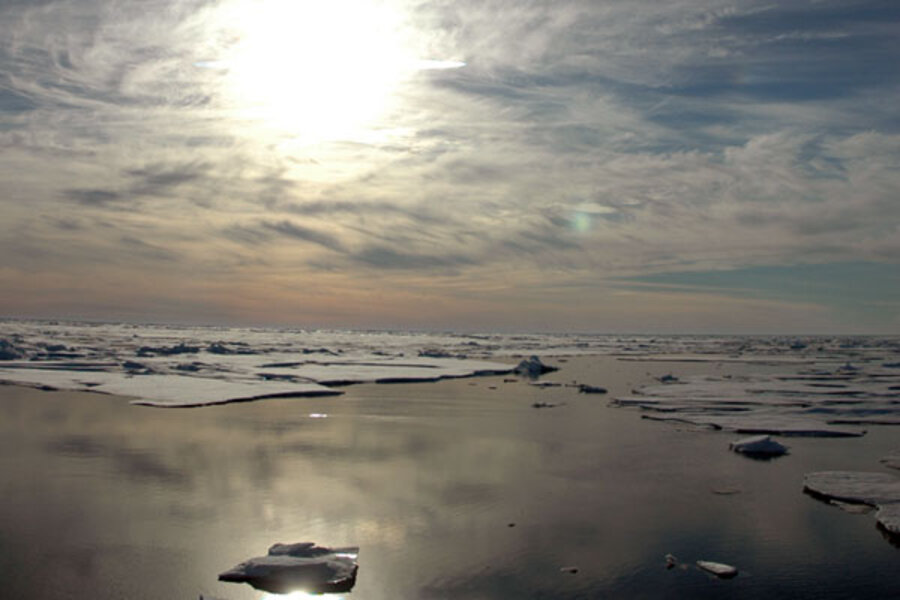Massive Arctic ice melt far surpasses previous record
Loading...
This summer's unprecedented melt for the icy white cap over Arctic waters appears to have come to a stop on Sunday, Sept. 16, setting a new record low for Arctic sea-ice extent that far surpasses the previous low set in 2007.
This summer, melt pushed the sea ice back to 1.32 million square miles (3.41 square kilometers), according to the U.S. National Snow & Ice Data Center, which tracks sea ice using satellite data.
"It definitely is a further indication that Arctic sea ice has become a lot more vulnerable and is in long-term decline," said Claire Parkinson, a senior scientist who studies climate at NASA's Goddard Space Flight Center.
By comparison, on Sept. 18, 2007, Arctic sea-ice extent — the area of ocean with at least 15 percent ice cover — reached 1.61 square miles (4.17 square kilometers), NSIDC said. [8 Ways Global Warming Is Already Changing the World]
Arctic sea ice grows and shrinks in an annual cycle that follows the seasons. Summer melt comes to an end in September, when the ice reaches its annual low extent. Then colder temperatures cause the ice to reform through the winter.
The new record low didn't arrive out of nowhere. Satellite records, which go back to the late 1970s, show a long-term decline in the ice, Parkinson said.
More recently, the annual lows have shrunk below the longer-term average. The last six years have seen minimum sea-ice extents well below the average for 1979 to 2000, NSIDC data show. [10 Things to Know About Sea Ice]
Scientists who study sea ice have blamed a combination of natural fluctuations and human-caused warming for the increased loss of ice, although some differ as to how much humans have contributed, Parkinson said.
The fickle nature of weather plays an important role in ice extent in a given year. For instance, researchers believe an intense storm over the central Arctic Ocean in early August made a large contribution to this summer's unprecedented low.
Winds from the storm broke up the sea ice, and as a result, some ice was pushed farther south into warmer waters where it melted, meanwhile the remaining ice was buffeted by winds and waves, which contributed to its decay, Parkinson said.
"The individual years are affected a lot by whatever the weather is in those individual years," Parkinson said. Next year's sea-ice growth will be starting from a lower point than ever before. However, that doesn't guarantee another record low in September.
"If next year ends up with calm conditions and maybe not quite as warm then the ice cover could make a nice rebound," she said. "We really don't know about next year."
Longer-term changes, with at least some human fingerprints on them, are also underway.
The thicker, multi-year ice, which lasts through many seasonal melts, has been declining. This change can't be explained by natural fluctuations, Walt Meier a research scientist with the NSIDC told LiveScience. The thinner, younger ice is more vulnerable to warming and to storms like August’s, he has said.
The loss of ice creates a positive feedback loop, since ice reflects much of the sun's energy, while the darker ocean water absorbs it. The more water exposed, the more energy is absorbed. In recent years, unusually high sea-surface temperatures have been recorded in the Arctic Ocean, and these are linked, in part, to the loss of the reflective ice cover, according to the NSIDC.
Another factor contributing to melt is black carbon, a type of soot released by the burning of fossil and other fuels. These particles fall on the ice, lowering its reflectivity and so accelerating its melt. But their contribution to the melt is not well understood, Meier told LiveScience in an email.
Sea-ice extent matters for a number of reasons. Because less sea ice means the oceans absorb more of the sun's energy, the decline in sea ice is expected to accelerate the effects of global warming.
It also creates problems for animals, such as polar bears and walruses, which depend on sea ice for habitat.
Follow LiveScience on Twitter@livescience. We're also on Facebook & Google+.





